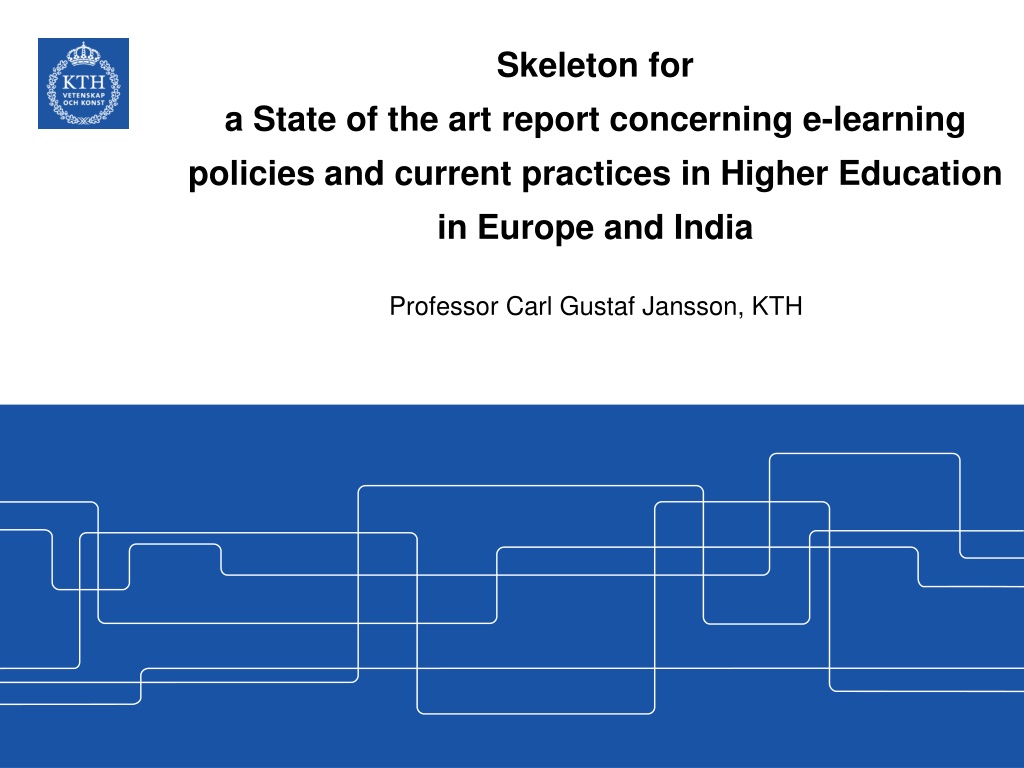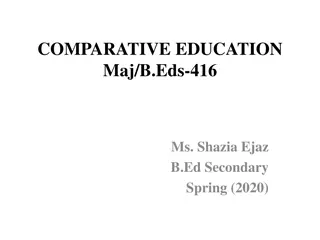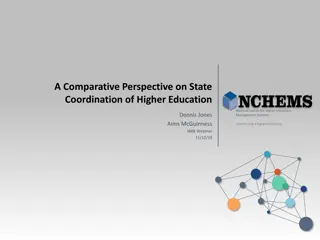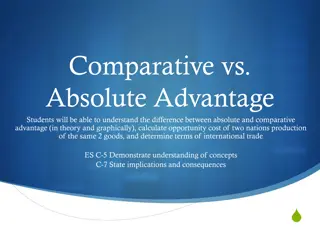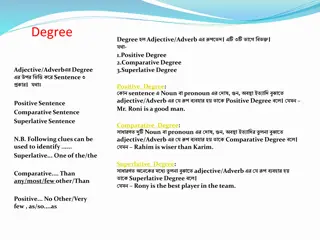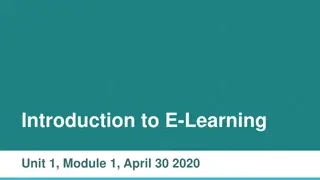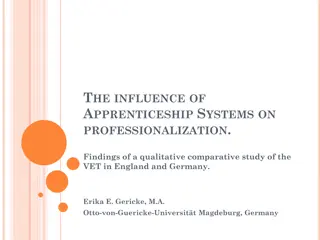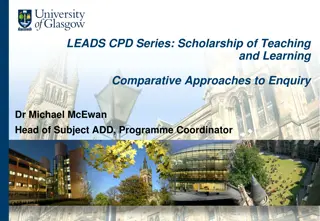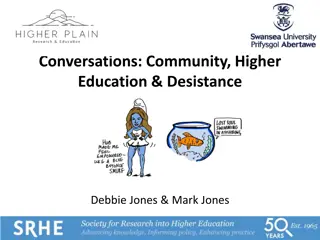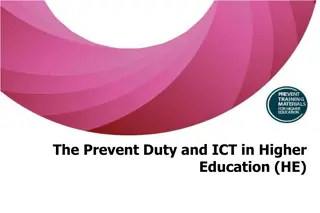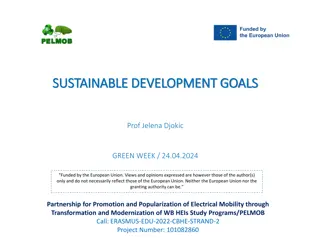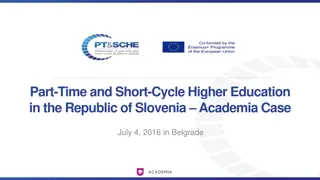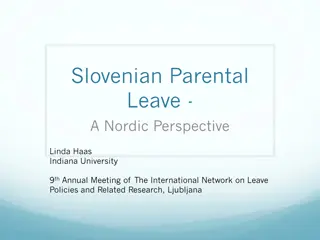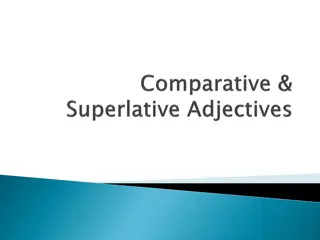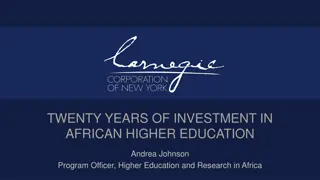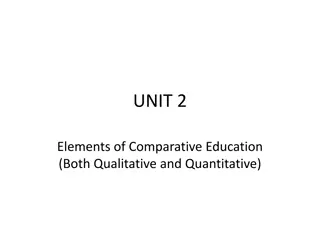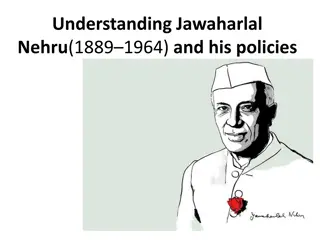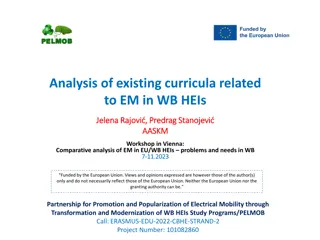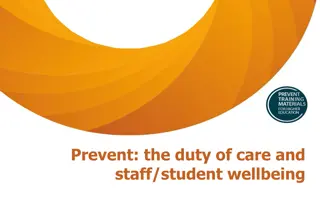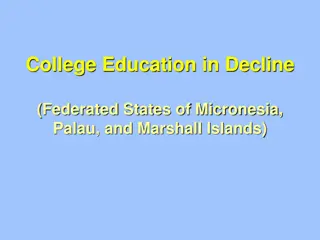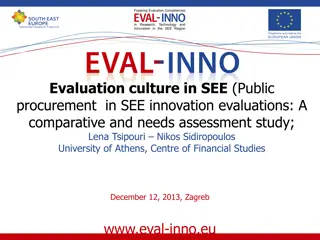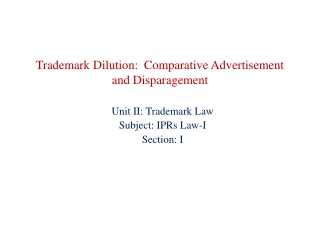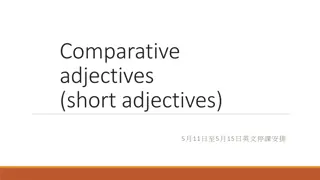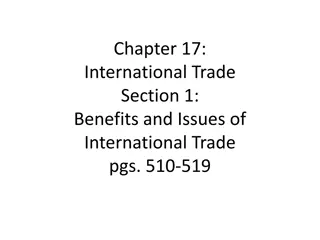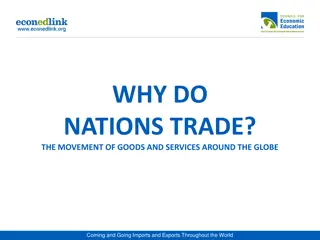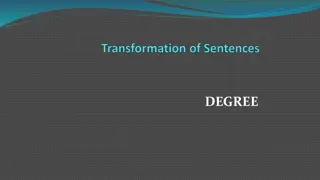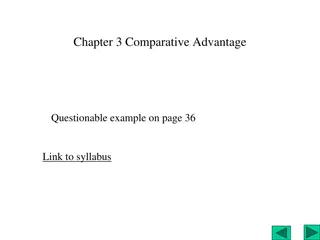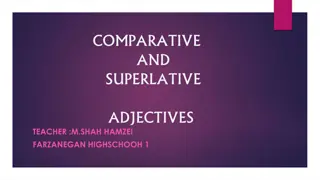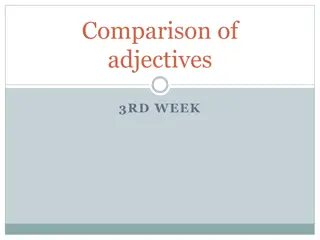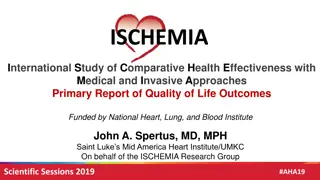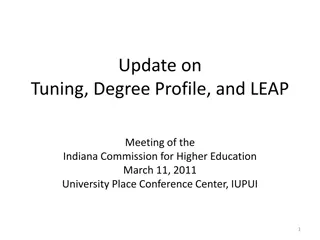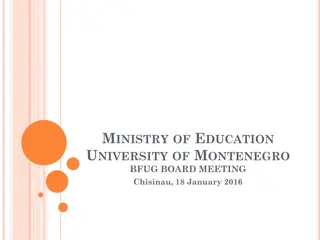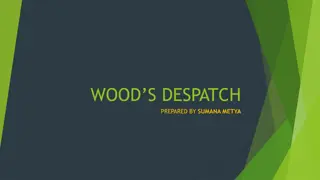Comparative Study of E-Learning Policies in Higher Education: Europe vs. India
This state-of-the-art report explores e-learning policies and practices in Higher Education in Europe and India, focusing on the MIELES project that aims to enhance knowledge transfer between European and Indian HEIs. The project includes various partners from both regions and aims to improve e-learning strategies and capacity building in Indian institutions. The report delves into the role of Higher Education Institutions (HEIs) in delivering post-secondary education and the evolving landscape of e-learning in the context of India's vast education system.
Uploaded on Oct 02, 2024 | 0 Views
Download Presentation

Please find below an Image/Link to download the presentation.
The content on the website is provided AS IS for your information and personal use only. It may not be sold, licensed, or shared on other websites without obtaining consent from the author. Download presentation by click this link. If you encounter any issues during the download, it is possible that the publisher has removed the file from their server.
E N D
Presentation Transcript
Skeleton for a State of the art report concerning e-learning policies and current practices in Higher Education in Europe and India Professor Carl Gustaf Jansson, KTH
The MIELES project The General Objective of the MIELES project is to enable transfer of knowledge between European HEIs and Indian HEIs regarding their e-Learning strategies and the realization of these. India has one of the largest education systems in the world with over 600 universities, 35,500 colleges, and 4 million schools. Realizing the opportunities in India, many e-learning organizations (domestic and international) have been offering their services in India. To secure quality, there is a need to enhance the Indian HEIs ability to contribute and to compete with other actors. The specific objectives with respect to e-learning are to: support Indian HEIs to assess their interests and needs build the capacity of Indian institutions to develop clear, realistic, and tailored strategies enhance the capacity of Indian institutions to implement their institutional strategies enable transfer of knowledge among different kinds of HEIs within India enhance Indian-European collaboration. Two important aspects are: The utilization of the upgraded ICT infrastructure in India Staff training. .
Partners in the MIELES project In India University of Mysore UOM MEA Engineering College MEA EC Kahm Unity Women s College KUWC Amrita University Indian Institute of Technology Madras IITM Indian Institute of Science IISC Bangalore Edulink Private Limited EDL In Europe KTH TUB University of Barcelona U. Roma Sapienza University of Peloponnese Centre for the Advancement of Research and Development in Educational Technology LTD CARDET LTD European Association for Quality Assurance in Higher Education ENQA
Higher Education Institutions (HEIs) A HEI is an institution that delivers higher education, post-secondary education, or third level education. It is an optional final stage of formal learning that occurs after completion of secondary education. The basic business model of a HEI is to deliver Degrees defined by and based on the completion of Programs of Courses. The kind of Degrees a HEI can provide are restricted by national or regional legislation. HEIs can receive financial support from both national, regional, private and special funding sources. The financial conditions for a particular HEI is regulated nationally and regionally. The traditional form for HEI education is a co-located campus based education, integrated with individual homework. Increasingly, HEIs also support partly or wholly distance education (dislocated from campus for longer periods). The classical HEI is a Compehensive University providing education in all subjects. Single/limited faculty HEIs provide education in specific subjects areas such as medicin, engineering, agriculture or business. Some HEIs (Specialiced colleges) are even more restricted as the only deliver. HEIs deliver both vocational education or more general academic education. As an additional service, a HEI can also provide singular courses for private or professional use on demand from both individuals and organizations. In this way HEIs can function as providers of both life-long and professional education.
Categorization of MIELES HIE partners In India University of Mysore a comprehensive HIE Amrita University - a comprehensive HIE Indian Institute of Technology Madras a single faculty HIE in Engineering Indian Institute of Science Bangalore - a single faculty HIE in Engineering MEA Engineering College - a single faculty HIE in Engineering offering only undergraduate education Kahm Unity Women s College KUWC. Comprehensive HIE but specialized In Europe KTH a single faculty HIE in Engineering TUB a single faculty HIE in Engineering University of Barcelona having all faculties except Engineering and Medicin U. Roma Sapienza - a comprehensive HIE University of Peloponnese a HIE limited to Humanities, Art and Social Science For all single faculty HIEs in engineering, strong science amd math departments are included.
e-learning On this slide the term learning is used but it is for our purposes equivalent to the term education. e-learning is used as the generic term refering to the substantial use of information and communication technology to support learning in a specific context. By online learning we refer to the systematic provision of course material via the WWW. The size of the pieces of material can vary from very small ( nuggets ), via sections of courses, complete courses up to complete programs. The most common form of use of on-line learning we refer to as Blended learning , meaning a still traditional form of campus-based education but where on-line material is used in a systematic way. The access to on-line material provides opportunities for more or less radical forms of changed but still campus-based educational models. An example of that is the Flipped Classroom . If distance learning is allowed for, a spectrum of designs can be enabled based on online material. One extreme here is a Massive Open On-line Course (MOOC) which is an online course aimed at unlimited participation and open access via the WWW. The existence of online material and collabortaion tools can also enable Collaborative learning by distributed student groups that resides on different sites. Finally, e-learning also includes the use of ICT to enable totally new pedagogical schemes, like game-based learning, simulations and VR learning environments, but specific such matters are of secondary importance for this project.
Current on-line offers frome MIELES HIE partners In India University of Mysore offers a portfolio of online courses Amrita University - competence, ambition but still a marginal offering Indian Institute of Technology Madras within the NPTEL framework provides a substantial portfolio of on-line courses Indian Institute of Science Bangalore - provides a substantial portfolio of on-line courses MEA Engineering College competence, ambition but still a marginal offering nity Women s College competence, ambition but still a marginal offering In Europe KTH competence, ambition but still a marginal offering TUB competence, ambition but still a marginal offering University of Barcelona offers a portfolio of online programs U. Roma Sapienza - competence, ambition but still a marginal offering University of Peloponnese competence, ambition but still a marginal offering
Indian HEIs not represented in Mieles but having large offers of online courses. *The content and quality of the online courses has not been investigated Yashwantrao C. Maharashtra Open University Nashik IMT Distance and Open Learning Institute Sikkim Manipal University Symbiosis Centre for Distance Learning MP Bhoj (Open) University Dr. BR Ambedkar Open University (BRAOU) Ghaziabad Gangtok Pune Bhopal Hyderabad Netaji Subhas Open University University of Mumbai (IDOL) Maharishi Dayanand University (DDE) Maulana Azad National Urdu University (DDE) Kolkata Mumbai Rohtak Hyderabad University of Delhi (SOL) Annamalai University (DDE) Dr. Babasaheb Ambedkar Open University Karnataka State Open University Acharya Nagarjuna University (CDE) The ICFAI University Sikkim Osmania University (PGRRCDE) Alagappa University (DDE) Shivaji University (CDE) The ICFAI University Tripura New Delhi Annamalainagar Ahmedabad Mysore Guntur Gangtok Hyderabad Karaikudi Kolhapur West Tripura SNDT - Women's University (CDE) Mumbai
International actors on the Higher Education market relevant for the topic of E-learning General e-learning providers Coursera edX Udacity Udemy Sailor Providers of e-learning platforms learning management systems Moodle Canvas Sakai TicTac
The USA HEI e-learning scene MIT Stanford Georgia Tech Columbia Cornell Duke Harvard U. Of California Berkely John Hopkins
Template for the state of current practise fact sheet for HEI - 2016 Yearly HEI KPIs: # of undergraduate students, # of PhD students, # of degrees on undergraduate level, # of degrees on PhD level, # of full time employees, # of full professors, # of associate professors, turnover = -------- , ---------- % undergraduate education share of turnover. Type of HEI ------------- Degree awarding rights ------- Funding schemes for education ---------- Types of e-learning offers Blended learning: Objectives ------ Online learning material coverage at present= ---- %, Platforms: -----------Envisioned education improvements include --------------------. MOOCS: Objectives ------- # of ourses offered at present = --- , Platforms: -------------- Modifications of general HEI business model due to e-learning use: ----------------- Disruptive pedagogical advancements through e-learning: -------------------- Fully on-line degree programs (MOOPs) offered : ----------------- Engagements in professional education and continued education for individuals: ------------------
HEI available policy statements .. ......
State of current practise fact sheet for KTH 2016 Yearly HEI KPIs: 13000 undergraduate students, 1800 PhD students, 2300 degrees on undergraduate level, 280 degrees on PhD level, 3600 full time employees, 310 full professors, 290 associate professors, turnover: 5 M SEK , 20% undergraduate education share of turnover, KTH is a singly faculty HEI in engineering but with degree awarding rights on all levels. A majority of Swedish and European students funded by the Swedish government. Out of 13000 students, are 650 selfpaying. E-learning offers Blended learning: The objective is to provide a majority of the course material for all on-campus courses in online form in a three year perspective. Online learning material coverage at present=25%, Platform: Canvas. Envisioned education improvements include: individualized learning without additional costs, preparatory course modules, flexible re-examinations, homogenized course content across course versions and the flipped classroom. MOOCS: The objective is to provide open access to s subset of learning resources as a service for anybody and primarily with a KTH branding and marketing purpose. There is no formal coupling to normal KTH courses and programs. Courses offered at present : 5, Platform: Edx. Modifications of general HEI business model due to e-learning use: very marginal or absent.A very small share of KTH turnover is afffected by e-learning. Disruptive edagogical advancements through e-learning: marginal and experimental. Fully on-line degree programs (MOOPs) offered : none, singular experiments with semester long provisions of fully on line sub-programs within regular programs. Engagements in professional education and continued education for individuals: to some extent.
KTH available policy statements Information technology as an integral part of everyday life has altered conditions for university studies fundamentally by 2027. Competition is becoming global when courses, to an ever larger extent, are offered via cloud computing networks and when teaching materials are becoming omnipresent. e-education is a self-evident part of competitive bids for university studies. There is a special challenge in acquiring and maintaining a leading position in both ICT research and e-education. KTH Vision 2027. Competition for the best students is becoming more global as courses are increasingly being offered on the Internet and teaching materials are easily accessible. This means that the virtual campus is becoming just as important as the physical one. Considering these aspects and the globalization of education, KTH must be prepared to take rapid action to execute an initiative within, for instance, e-learning. This is not a matter of distance education of the classical type; this is a paradigm shift where the virtual dimension is integrated into education. At the same time, the significance and added value of physical presence on campus should be emphasized. KTH Development Plan 2017.
